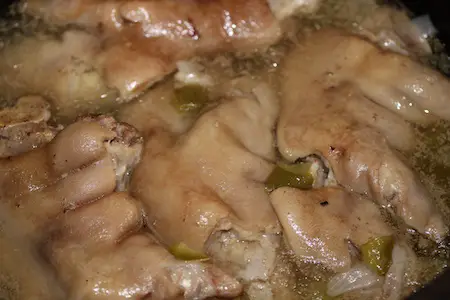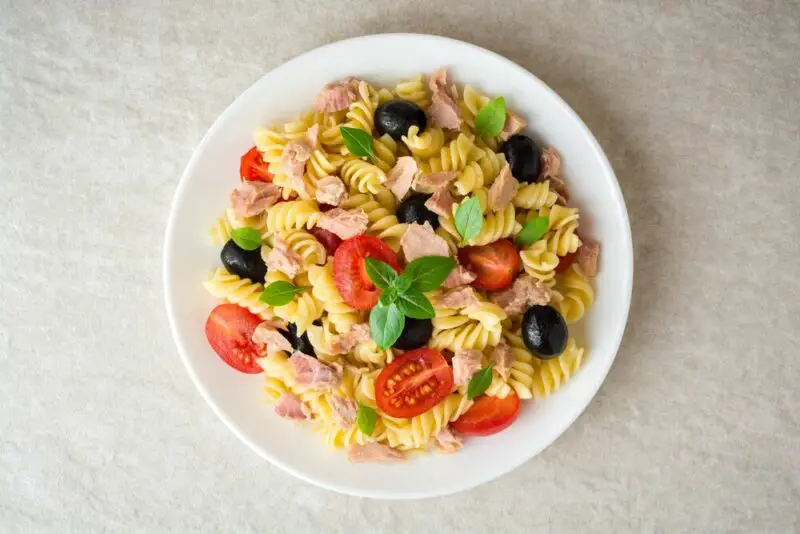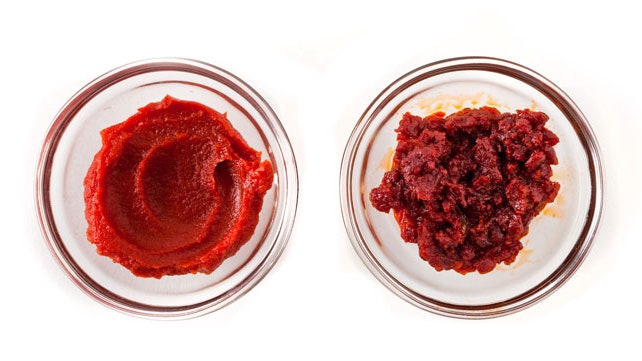How to Cook Pig’s Feet in the Oven: A Complete Guide
Pig’s feet may not be a popular dish for many, but they are a delicacy in many cultures around the world, especially in the Southern United States. They were once considered poor people’s food but have slowly made their way into restaurant menus and home kitchens. If you’ve never cooked pig’s feet before, don’t be intimidated; this guide will help you cook tender and flavorful pig’s feet that will impress even the pickiest of eaters.
Introduction
Before we dive into how to cook pig’s feet, let us understand what pig’s feet are as a culinary ingredient. Pig’s feet are the hock or ankle joint of a pig and contain connective tissue that is rich in collagen. There is evidence that pigs’ feet have been consumed for thousands of years, dating back to Ancient Rome. As pigs are relatively inexpensive animals to rear and use efficiently in culinary, pig’s feet continue to be used today in various dishes.
Knowing how to cook pig’s feet may seem irrelevant compared to knowing how to cook a filet mignon or other high-grade cuts. But the ability to transform tender cuts with rich textures distinguishes great cooks from novice ones. Also, sustainability-minded cooks looking for ways to reduce food wastage find Pig’s feet valuable since Nose-to-tail eating continues gaining momentum.
Preparing Pig’s Feet
The key to good pig’s feet is preparing them well before roasting or braising in the oven.
Choosing High-Quality Pig’s Feet
The first step towards cooking outstanding Pig’s feet is selecting high-quality pork meat. Look for fresh or frozen joints with no bruises, spots, discoloration or foul odor. Pig’s feet are often sold cooked and canned, but these do not give the same results when roasted or braised.
Cleaning and Trimming Pig’s Feet
Thoroughly clean your pig’s feet under running water with a brush to remove any dirt and impurities. If the hair has not been removed during processing, shave it off gently with a sharp knife before washing.
Once cleaned, remove loose skin and fat using a sharp knife. Be careful not to remove too much fat since they contain much of the nutrition required by the body.
Soaking or Brining Pig’s Feet
While not mandatory, soaking or brining pig’s feet in advance may significantly help improve flavor and texture. Soaking helps extract salt and easy-to-tenderize compounds from pig feet. If you are looking for dishes with an incredibly soft texture and low salt levels, soaking is necessary.
To soak pig’s feet, submerge them in water seasoned with vinegar, lemon juice, white wine or any acid that will break down the tough fibers overnight. To create a brine solution, you can dissolve salt, sugar, aromatics, herbs/spices in water only or add vinegar or an acidic ingredient as well.
Patting Dry and Seasoning Pig’s Feet
Before cooking pig’s feet in the oven, pat them dry using paper towels to remove excess moisture. Then season them generously because they need bold flavors to make them palatable. You can use a mix of sweet and savory elements like paprika powder, brown sugar, onion powder, garlic powder to cover breasts evenly with adequate seasoning. If you like spicy food offerings like chili flakes or cayenne pepper.
Roasting Pig’s Feet in The Oven
Roasting pig’s feet in the oven is a great way to get crispy and tender meat with minimal prep time. Follow these tips to roast pig’s feet in the oven.
Choosing an Oven-Safe Dish to Roast Pig’s Feet
You would need an ovenproof dish that can hold at least two pounds of meat with enough space to allow even cooking. Pyrex, ceramic or stainless-steel baking dishes are examples of appropriate choices.
Preheating the Oven to the Correct Temperature
Preheat your oven at 375 degrees Fahrenheit before placing your seasoned pig’s feet in your chosen oven-safe dish.
Properly positioning Pig’s Feet in the Dish
The meat must not touch each other while they cook since this can cause uneven cooking. The best way to arrange them is by making equal space between each joint so that hot air can circulate freely around it. Cover the dish with aluminum foil and ensure that the covering is tight enough to avoid any excess wastewater from spilling over and causing extra cleaning.
Roasting Time And Tips for Achieving A Crispy Texture
Crisping up the unsightly joints require patience and technique. Start by baking covered pork feet as is for two hours, then increase temperature slightly gifting particular attention every 10-15 minute intervals. Alternatively, towards the end of cooking, you could remove foil from your dish and move your oven temperature up a notch. Turn pig’s feet off after checking if they achieved your desired texture and let them rest for a few minutes before serving.
Braising Pig’s Feet in The Oven
Braising involves cooking pig’s feet low and slow in a flavorful liquid until the meat falls off the bone. The technique demands fewer seasoning elements compared to roasting, though it may take more time overall to prepare.
Advantages of Braising over Roasting Pig’s Feet
Braising is an excellent way to give pig’s feet a deliciously soft and buttery texture. The slow-cooked meat feels like it practically melts in your mouth, while the simmering liquid generates rich and concentrated flavors for a complex taste. Another perk is that Braised meat is less likely to attempt chewiness effectively. For those who don’t like biting anything with lots of resistance chowing on braised Pig’s will feel fulfilling.
Choosing an Oven-Safe Pot for Braising Pig’s Feet
Select an oven-proof pot that is perfect for accommodating pig’s feet by checking that the capacity is large enough to let each joint rest separately.
Preparing A Flavorful Braising Liquid
You need a tasty liquid or “broth” for braising since it will impart its flavor into the meat. Some common liquids used for braising include stocks, wine, beer, tomato sauce|canned tomatoes or other acidic & aromatic flavorings
Adding Aromatics and Vegetables To Enhance The Flavor
You can add any vegetable that can handle long cooking times in the remaining broth, you also get some fantastic blending of flavors when you do this.If you want an easy combination try onions, garlic cloves or ginger roots as they pair very well with pork meat.
Slow-Cooking Pig’s Feet in The Oven
Slow-cooking pig’s feet in the oven entails baking them low and slow with seasonings until tender.
Importance of Low and Slow Cooking For Tender Pig’s Feet
Slow cooking pig’s feet, or any other tough meat, breaks down tendons and tissues gradually leading to breaking down of muscles that eventually result in a delectably tender piece of meat.
Choosing an Oven Safe Pot with A Tight-Fitting Lid
You need a tight cover for slow-cooking pork feet since the meat will expel moisture while it cooks. Pick an oven-proof pot with tight-fitting lid. Ceramic and enameled cast iron pots are best when accented with enough moisture to ensure even cooking on all sides.
Using Seasoning and Flavorings for Added Depth of Flavor
Seasoning pork feet cushions the natural taste of the meat while giving it its unique flavor profile. Use dry spices like rosemary, thyme, cumin, chilli powder or bay leaves that can withstand hard boiling without losing flavor integrity.
Cooking Times And Temperatures Based on Different Recipes
The duration taken before your joint of pork is ready will depend not only on your oven temperature but also on how long you choose to let your pork braise. Most recipes typically call for a minimum of 3 – 6 hours in length.
Serving Suggestions
Traditional Dishes Featuring Cooked Pig’s Feet From Around The World
- Pigs’ Trotters Creole – from Louisiana: A Classic Creole dish flavored with Cajun spice, celery, onion, green peppers, garlic cloves served over rice.
- Tuscan Stewed Italian Pig Feet & Beans– cooked in their own juice added with beans and seasoned with sage.
- Southern Style Pig’s Feet & Peas – consisting of pig’s’ feet simmered in tomato sauce and served with black eyed peas.
- Korean Pig Feet – Jokbal: made with slow-cooked feet seasoned with soy sauce, ginger, garlic cloves.
Pairing Options for Serving Cooked Pig’s Feet At Home
You can choose to serve pig’s feet as the main course or as a side dish or even use them as a base for making soups, stews, casseroles or delicious sandwiches. You can pair it with bread of your choice alongside marinade like honey, Dijon mustard, white balsamic or steak butter.
Alternative Serving Ideas Aside from Main Dishes
If you want to use pig’s feet in creative ways, you can make stocks and broths since the limbs are perfect for an eventual collagen-rich soup base without adding any thickener. Meat parts like joints could also be blended into subtle spreads that deposit an intriguing punch to pies, boiled eggs or spicy dips.
Tips For Achieving Delicious Results Every Time
Understanding How Oven Temperatures Affect The Final Dish
The temperature influences how fast your pork cooks and its final texture. Thus checking meat frequently is vital when working low and slow such as braising.
The Importance of Patience When Cooking Pig’s Feet
To achieve the perfect texture usually desired from this cut of meat will take time. For best results it is best you let the cooking process happen at its pace so that the meat tenderness can be realized slowly over long hours of cooking.
Frequently Encountered Problems And How To Work Around Them
- Too Tough- cook them for longer periods since collagen needs enough time to break down.
- Too Salty –soak them in water or broth beforehand
- Blandness – add more salt or flavorings when slow cooking or/and try blending spices.
Health Benefits of Eating Pig’s Feet
- Increase Relieve Joint Pain – Connective tissues and cartilage compounds like Chondroitin Sulfate, Glucosamine found in pig’s feet bolster the joints ability to remain lubricated and reduce swelling, ideal for arthritis patients.
- High Nutritional Value- Highly nutrient-dense with vitamins and minerals
- Low Fat Content – Compared to other pig meat cuts, trotters contain lower fat amounts by default with a decent amount of protein included.
Conclusion
Cooking pig’s feet is a culinary experience that everyone should try at least once. It might not be everyone’s cup of tea, but it is worth trying it. With this guide, you can now cook tender and flavorful pig’s feet effortlessly. Don’t forget that making pig’s feet is a lovely way to become a gratifying cook addition in your kitchen remarkable.
Frequently Asked Questions
Can I cook pigs feet in the oven instead of on the stove?
Yes, you can cook pigs feet in the oven instead of on the stove. In fact, cooking them in the oven can be more convenient and hands-off than simmering them on the stove for hours.
What is the best way to season pigs feet?
The seasoning depends on personal taste preferences. However, a simple seasoning of salt, pepper, garlic powder, and onion powder works well to enhance the traditional flavor.
How long should I cook pigs feet in the oven?
Pigs feet should be cooked in the oven for at least 2-3 hours at 350°F until they are tender enough to fall off the bone. You can also add water or broth to prevent them from drying out.
What side dishes pair well with oven-cooked pigs feet?
Oven-cooked pigs feet pair well with a variety of side dishes. Some popular choices are mashed potatoes, cornbread, cooked greens, black-eyed peas, and coleslaw. Additionally, you can add a dollop of hot sauce and a slice of cornbread to elevate your meal to another level!






